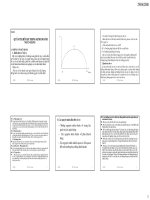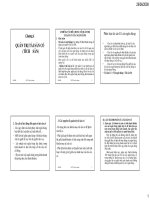slike bài giảng quản trị ngân hàng chương 4managing and pricing non-deposit liabilities
Bạn đang xem bản rút gọn của tài liệu. Xem và tải ngay bản đầy đủ của tài liệu tại đây (321.67 KB, 36 trang )
William Chittenden edited and updated the PowerPoint slides for this edition.
MANAGING AND PRICING
NON-DEPOSIT LIABILITIES
Chapter 4
Key topics
1. Liability management
2. Customer relationship doctrine
3. Alternative non-deposit funds sources
4. Measuring the funds gap
5. Choosing among different funds sources
6. Determining the overall cost of funds
13-2
Customer relationship doctrine
The first priority of the bank is to make loans to all
qualified customers and if funds are not available
the bank should seek out the lowest cost source of
funding to meet customers’ needs.
13-3
Liability management
The bank buys funds in order to satisfy loan requests
and reserve requirements
It is an interest-sensitive approach to raising bank
funds
It is flexible – the bank can decide exactly how much
they need and for how long
The control mechanism to regulate incoming funds is
the price of funds
13-4
Nondeposit sources of funds
Federal Funds Market
Repurchase Agreements
Federal Reserve Bank
Advances from the Federal Home Loan Bank
Negotiable CDs
Eurocurrency Deposit Market
Commercial Paper
Long Term Sources
13-5
Recent Growth in Non-deposit Sources
of Borrowed Funds at FDIC-Insured Institutions
What are the trends?
13-6
Alternative non-deposit sources of funds
The usage of non-deposit sources of funds has risen
Larger institutions rely on the non-deposit funds
market as a key source of short-term money to meet
loan demand and unexpected cash emergencies
13-7
Federal funds market
Immediately available reserves are traded between
financial institution and usually returned within 24
hours, although maturities are negotiated and can
extend up to several weeks
Deposits with correspondent banks and demand
deposit balances of security dealers and governments
can be used for loans to institutions.
Interest rates are negotiated between trading partners
and are quoted on a 360-day basis
13-8
13-9
Types of Fed funds loan agreements
•
Overnight loans
Negotiated via wire or telephone, returned the
next day
Normally not secured by specific collateral,
although might
•
Term loans
Longer term Fed funds contracts (several days,
weeks, or months)
•
Continuing contracts
Automatically renewed each day
Normally between smaller respondent institutions
and their larger correspondents
13-10
Repurchase agreements (Repos)
Can be thought of as collateralized FED funds
transactions; more complex; less exposure to credit
risk
Involves the temporary sale of high-quality assets
(usually Government securities) accompanied by an
agreement to buy back those assets on a specific
future date at a predetermined price or yield
13-11
Repurchase agreements
Most transactions are overnight
In most cases, the market value of the collateral
is set above the loan amount when the contract
is negotiated.
This difference is labeled the margin
The lender’s transaction is referred to as a
Reverse Repo
Borrowing from the Federal Reserve
Discount window
Discount rate
Policy is to set discount rate 1% (1.5%) over the Fed
Funds target for primary (secondary) credit loans
To borrow from the Federal Reserve, banks must apply
and provide acceptable collateral before the loan is
granted
Eligible collateral includes U.S. government
securities, bankers acceptances, and qualifying
short-term commercial or government paper
Borrowing from the Federal Reserve
Primary Credit
Available to generally sound depository institutions on a
very short-term basis, typically overnight
It serves as a backup source of short-term funds for
sound depository institutions
Secondary Credit
Available to depository institutions that are not eligible
for primary credit. Monitored by the federal reserve to
control excess risk
Borrowing from the Federal Reserve
Seasonal Credit
Cover longer periods than primary credit to assist small
depository institutions in managing significant seasonal
swings in their loans and deposits
Emergency Credit
May be authorized in unusual and exigent circumstances
by the Board of Governors to individuals, partnerships,
and corporations that are not depository institutions
Federal home loan bank advances
The FHLB system is a government-sponsored
enterprise created to assist in home buying
The FHLB system is one of the largest U.S.
financial institutions, rated AAA because of the
government sponsorship
FHLB has federal charter and can borrow cheaply
and pass savings to institutions
FHLB Has 12 Regional Banks
Any bank can become a member of the FHLB
system by buying FHLB stock
Advances from the Federal Home Loan Bank
If it has the available collateral, primarily real
estate related loans, it can borrow from the
FHLB, as a way to improve the liquidity of
home mortgages and encourage more lenders
to provide credit
FHLB advances have maturities from 1 day to
as long as 20 years
Number of loans has increased dramatically in
recent years
13-17
Commercial Banks with FHLB Advances,
1991–2004
Commercial Banks with FHLB Advances
$50
$100
$150
$200
$250
$300
$350
$400
$450
Billions of Dollars of FHLB
Advances
100
1,100
2,100
3,100
4,100
5,100
Number of Banks with FHLB
Advances
Amount Outstanding (Billions)
Number of Banks
Negotiable CD
An interest-bearing receipt evidencing the deposit of
funds in the bank for a specified period of time for a
specified interest rate. It is considered a hybrid
account since it is legally a deposit
13-19
Four types of negotiable CDs
Domestic CDs – issued by domestic banks in the U.S.
Euro CDs – dollar denominated CDs issued outside the
U.S.
Yankee CDs – issued by foreign banks in the U.S.
Thrift CDs – issued by large savings and loans and
other nonbanks in the U.S.
13-20
Eurocurrency deposit market
Eurodollars are dollar-denominated deposits placed
in banks outside the U.S.
Eurocurrency deposits originally were developed in
Western Europe to provide liquid funds to swap
among institutions or lend to customers
Labeled ‘Liabilities to foreign branches’ when a
foreign branch lends Euro-deposits to its home
office
13-21
Commercial paper
Short-term notes with maturities from 3 or 4 days
to 9 months issued by well-known companies.
Two types
Industrial paper - purchase inventories
Finance paper – issued by finance
companies and financial holding companies
Banks cannot issue these directly but affiliated
companies can issue them.
13-22
Long-term non-deposit sources of funds
Mortgages to fund the construction of new
buildings.
Capital notes and Debentures are examples of long
term sources of funds
13-23
The Funds gap
Gap is based on:
Current and projected demand and
investments the bank desires to make
Current and expected deposit inflows and
other available funds
Size of this gap determines need for non-deposit
funds
13-24
Non-deposit funding sources: factors to
consider
Relative costs of raising funds from each source
Risk of each funding source
Length of time for which funds are needed
Size of the institution
Regulations limiting the use of various funding
sources
13-25









